 |
Karlovac Fortress
Karlovac, Croatia
|
Unusual! I usually use a current satellite shot of a starfort for the main image on its page, but Karlovac Fortress looks so much nicer in this 18th century map than it does today! Click on it to see the whole map. |
 |
Constructed: 1579-1587
Used by: Austria, Yugoslavia, Croatia
Conflict in which it participated: Ottoman-Habsburg Wars
|
In the mid-16th century, Europe and Asia were under the constant threat of the expansionist whims of the wicked Ottoman Empire. Austria was on the front lines, defending all that was good and decent, and/or Christian.
Charles II (1540-1590), Archduke of Austria, worked out a deal with the nobility of Inner Austria to construct a strongpoint on the Croatian frontier: The nobility would be permitted religious freedom (nobles: Protestant; Charles: Catholic) if they would foot the bill for this massive fortificational undertaking. |
 |
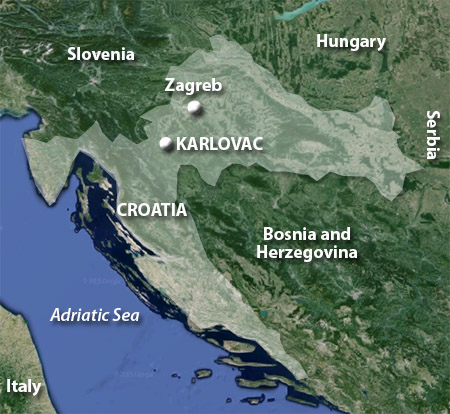 |
|
What would become the fortified city of Karlovac (Karlstadt in German) was built near the 13th-century Dubovac Castle, at the confluence of the Kupa and Korana Rivers. Construction began on July 13, 1579, and was overseen by George Khevenhüller (1533-1587). An Inner Austrian bigwig, "Court Chamberlain" to Charles II, Khevenhüller is reportedly remembered in Croatia as a bit of a cruel weenie, who worked the serfs harder than may have been absolutely necessary to build his fortified city. But then those serfs are always complaining about something.
Karlovac, which translates as Charles' City, was of course named for that Charles II fellow, in case you hadn't figured that one out yet.
|
The reason Karlovac was built where it was: The Kupa and Korana Rivers. |
 |
Like the Italian city-starfortress of Palmanova, Karlovac Fortress was intended to be both a fortification and a self-sustaining settlement: An advanced defense against the Ottoman Empire. Houses, shops and a church were built within Karlovac's starry walls, but the Austrians had to start over after everything within those walls inadvertently burned to the ground in 1594. The forces of the Ottoman Turks attacked and/or besieged the fortress at Karlovac a whopping seven times up until 1672, failing on each and every occasion to gain entry. |
|
|
Karlovac Fortress was modernized in the mid-17th century under the direction of military engineer Martin Stier (1620-1669), which is surely what kept the otherwise unstoppable Ottomans out. Once the unstoppable had been stopped at Vienna in 1683, the Turks were pushed back out of many of Austria's lands, and Karlovac became less important as a military outpost.
|
In the century following the Ottomans' withdrawal from the region, the growing city of Karlovac found it difficult to actually grow, due to the building restrictions that came along with the city being owned by the Habsburgs, and being designated a military outpost first and foremost. Queen Maria Theresa (1717-1780) finally returned Karlovac to the Croatian crown on August 9, 1776.
Though still associated with, and ruled by the Austrian monarchy, the residents of Karlovac were now free to develop their city as they saw fit. Karlovac blossomed through the 18th and 19th centuries, thanks to its strategic location on those life-giving rivers, which were of course the main mode of transportation and the shipment of goods in a world before railroads or even decent road-roads.
|
 |
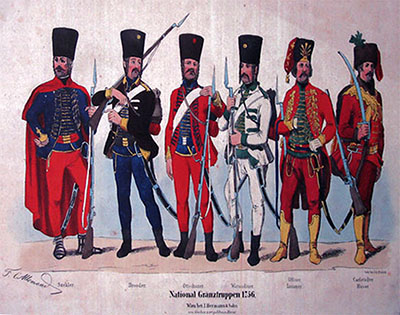 These well-groomed gentlemen are Austrian soldiers from the Croatian frontier, circa 1756. These well-groomed gentlemen are Austrian soldiers from the Croatian frontier, circa 1756. |
|
Croatia remained more or less part of the Austro-Hungarian Empire until 1918, when the Austro-Hungarian Empire ceased to be and Croatia became part of the new nation of Yugoslavia.
Which lasted until the Soviet Union imploded in 1991. Croatia declared independence from Yugoslavia in June of 1991, then spent the next four years fighting for that independence in the Homeland War (1991-1995), mainly against Serbian forces.
The vast amount of Soviet-era weaponry lying around made this war quite convenient for all concerned. The remains of much of this military matériel, in varying states of destruction, are on display by the old Austrian barracks in Karlovac Fortress, where an exhibit and/or museum dedicated to Karlovac's military history is planned.
|
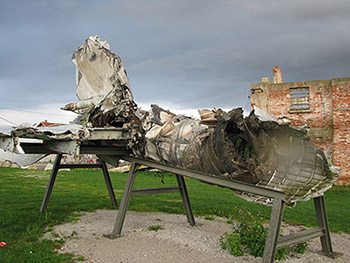 Remnants of the tail section of a Serbian MiG-21 warplane, currently sitting around Karlovac Fortress awaiting the construction of a museum of Croatian military history. |
 |
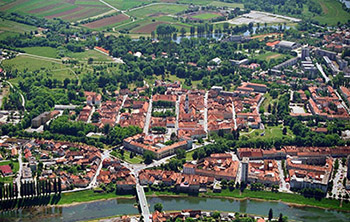 Karlovac today. Its starfort walls may not be the epitome of pointy defensiveness, but the old town is still shaped like a starfort, and is quite lovely. |
|
|
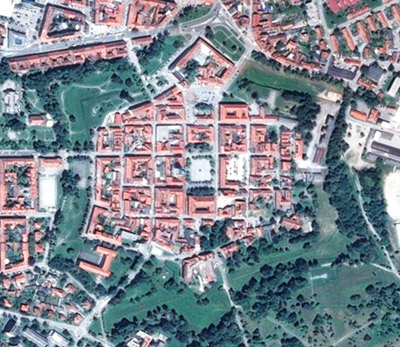 Karlovac today. Looks much nicer in the old map Karlovac today. Looks much nicer in the old map
at the top of the page, doesn't it!Ten thousand thanks to starfort enthusiast Miryana Baran, who pointed to Karlovac Fortress for us!
|
|
|
|
|
|
 |




